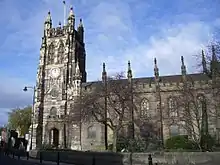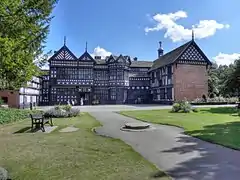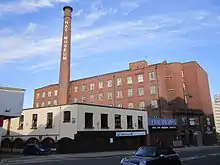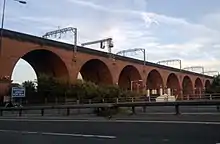Christ Church, Heaton Norris
Christ Church consists of the remains of a redundant Anglican church at Wellington Road North, Heaton Norris, Stockport, Greater Manchester, England. Only the tower and part of the walls of the aisles survive. They are located on the crest of a hill on the main road linking Stockport with Manchester.[1] The church remains are recorded in the National Heritage List for England as a designated Grade II listed building,[2] and are under the care of the Churches Conservation Trust.[3]
| Christ Church, Heaton Norris | |
|---|---|
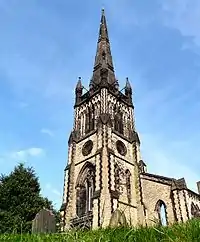 Tower of Christ Church, Heaton Norris | |
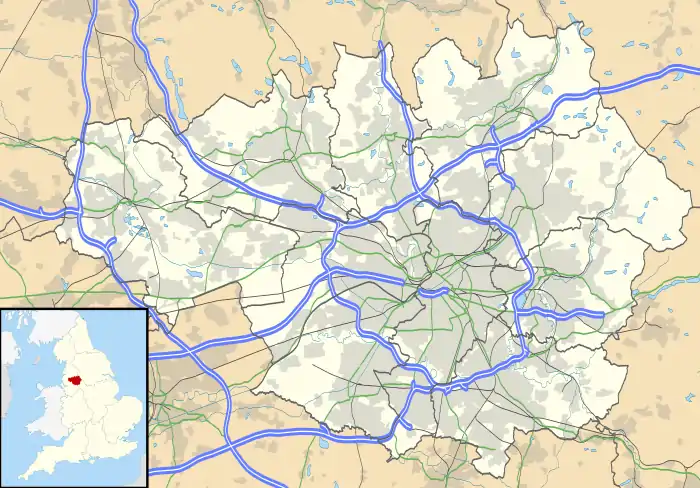 Christ Church, Heaton Norris Location in Greater Manchester | |
| OS grid reference | SJ 889 908 |
| Location | Wellington Road, Heaton Norris, Stockport, Greater Manchester |
| Country | England |
| Denomination | Anglican |
| Website | Churches Conservation Trust |
| Architecture | |
| Functional status | Redundant |
| Heritage designation | Grade II |
| Designated | 10 March 1975 |
| Architect(s) | William Hayley |
| Architectural type | Church |
| Style | Gothic Revival (Early English style) |
| Groundbreaking | 1844 |
| Completed | 1846 |
| Construction cost | c. £7,000 (equivalent to £683,000 in 2019) |
| Specifications | |
| Materials | Sandstone, Welsh slate roofs |
History
The church was built in 1844–46 on land donated by Wilbraham Egerton of Tatton Park.[1] It cost about £7,000 (equivalent to £683,000 in 2019),[2][4] and was a Commissioners' church, the Church Building Commission providing a grant of £500 towards its building.[5] It was designed by the Manchester architect William Hayley. As originally built, it consisted of a nave, north and south aisles, north and south transepts, a chancel, and a west tower with a spire.
By the 1970s the fabric of the church was in very poor condition, including the effects of dry rot. Attempts were made to convert it into a centre for the use of the community, but these were unsuccessful, and in 1977 it was badly damaged by a fire. Following this, it was demolished apart from the tower and spire, and parts of the adjoining walls. The foundations of the other walls have been preserved to show its original plan. Few of the fittings or furniture have survived; they were either destroyed in the fire or have been stolen. Several of the memorial plaques from within the church had, however, been removed prior to the fire and are now in All Saints' Church, Heaton Norris, along with the Christ Church Mother's Union banner, which has been recently restored (2014). The five clock bells, made by Warner in 1896, were stolen in 1977.[3] The church was declared redundant on 20 July 1973, and the remains of the church were vested in the Trust on 23 May 1979.[6]
Architecture
Christ Church is constructed in yellow sandstone with a Welsh slate roof. Its architectural style is Early English.[2] The tower is in four stages, and it has a tall, slender spire.[3] On the west side of the lowest stage is a portal, and above this in the next stage is a west window with plate tracery. On the north and south sides of this stage are paired lancet windows. In the third stage are circular openings that formerly housed the clock faces and in the top stage are paired bell openings. On the summit is a pierced parapet, with tall pinnacles at the corners and smaller intermediate pinnacles.[1][2] In the Buildings of England series, it is stated to be Hayley's "most ambitious surviving work".[1]
External features
The churchyard contains the war graves of five soldiers of World War I.[7]
A Sad Stockport Story
Two eight-year-old boys, Peter Barrett and James Bradley, killed two-year-old George Burgess, on 11 April 1861. The toddler was abducted from and smothered in a pool of water near Love Lane. He was last seen by his father, a powerloom weaver, near the Star Inn in Higher Hillgate; the child was being looked after by a nurse when he went missing. Peter Barrett and James Bradley had taken the toddler before stripping him, beating him with sticks, and then suffocating him in the brook. They had been challenged but not stopped by two residents and in court admitted to the crime, blaming each other. There had been a precursor to this incident: on 31 March the pair had been suspended from Stockport Sunday School when they had ripped up two Bibles and other children's caps. James Bradley served 4½ years at Bradwall Reformatory School and Peter Barrett was sent to a Reformatory in Warwickshire George Burgess was buried at Christ Church, Heaton Norris. The exact burial place of George Burgess is now unknown.
See also
References
- Hartwell, Clare; Hyde, Matthew; Pevsner, Nikolaus (2004), Lancashire: Manchester and the South-East, The Buildings of England, New Haven and London: Yale University Press, p. 233, ISBN 0-300-10583-5
- Historic England, "Christ Church, Stockport (1067165)", National Heritage List for England, retrieved 8 July 2013
- Christ Church, Heaton Norris, Lancashire, Churches Conservation Trust, retrieved 18 October 2016
- UK Retail Price Index inflation figures are based on data from Clark, Gregory (2017). "The Annual RPI and Average Earnings for Britain, 1209 to Present (New Series)". MeasuringWorth. Retrieved 2 February 2020.
- Port, M. H. (2006), 600 New Churches: The Church Building Commission 1818-1856 (2nd ed.), Reading: Spire Books, p. 335, ISBN 978-1-904965-08-4
- Diocese of Manchester: All Schemes (PDF), Church Commissioners/Statistics, Church of England, 2010, p. 6, retrieved 3 April 2011
- HEATON NORRIS (CHRIST CHURCH) CHURCHYARD, Commonwealth War Graves Commission, retrieved 6 February 2013
.jpg.webp)
